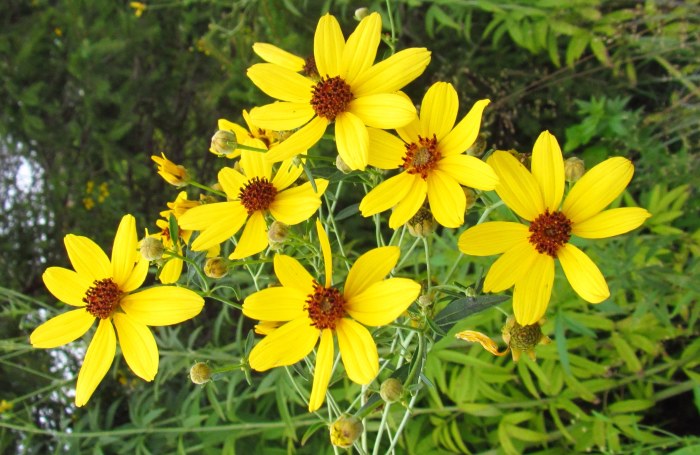Snow and freezing temperatures arrived early in Iowa this year, but I’m not ready to put Bleeding Heartland’s wildflower series to bed for the winter yet.
The bitter cold inspired me to pull out some summertime pictures for this week’s edition. I took all of the photographs enclosed below in the parking lot of the Greater Des Moines Botanical Garden in late August. Some wonderful prairie plantings are in front of the main building and along the nearby bike trail.
Tall coreopsis (Coreopsis tripteris), sometimes known as tall tickseed, is native to most of the U.S. and Canada east of the Rocky Mountains. UPDATE: Bleeding Heartland user PrairieFan notes in the comments that “tall coreopsis is native to the southern half of Iowa, but not the northern half.”
It can grow in many types of habitats, from disturbed ground to high-quality prairies. The Missouri Botanical Garden’s website advises that tall coreopsis is easy to grow “in dry to medium moisture, well-drained soil in full sun,” and “Thrives in poor, sandy or rocky soils with good drainage.”
According to Aaron Harpold, assistant director of horticulture for the botanical garden, the plants I photographed were a cultivar, not grown from seed collected in the wild. For any interested gardeners, the specific type is Coreopsis tripteris ‘Flower Tower.’
The Illinois Wildflowers and U.S. Wildflowers websites are good resources for botanically accurate descriptions of tall coreopsis foliage, flowerheads, and fruit. This shot shows the lower part of the stem and the leaves. Some leaves have five leaflets, as seen here.
Most tall coreopsis leaves have three leaflets, as seen on these plants.
The common name states the obvious: these plants tend to be taller than most coreopsis species. They can grow to heights of 6 to 8 feet. However, you may see shorter specimens, like this plant growing next to the curb.
Another not so tall coreopsis:
Like other plants in the aster family, what looks like a single flower is actually a flowerhead with yellow ray flowers resembling petals and numerous small florets in a central brown disk. Tall coreopsis flowerheads have eight ray flowers, which are rounded.
In this shot, some flowerheads are visible while other buds have yet to open.
A large cluster of tall coreopsis in bloom:
A closer look at the flowerheads, with some very tall plants in the background:
Tall coreopsis growing alongside purple giant hyssop:
I didn’t get a good shot of the dark, hard seeds, which look like ticks (hence the common name tickseed for this group of plants). But some of the flowerheads here have finished blooming.











3 Comments
What cheering photos, thank you
It’s easy for readers to vote, since we don’t do the work:-), and my vote would be to keep Wildflower Wednesdays going for as long into late fall as possible. The blood-pressure-lowering loveliness is a public service.
The USDA maps provide very good general ideas of plant ranges, but with the whole country to cover, it’s very understandable that the maps only give information by entire states. As it happens, tall coreopsis is native to the southern half of Iowa, but not the northern half.
PrairieFan Wed 13 Nov 9:59 PM
Some years I have ended the series
in October, but lately I have gone to the Wednesday before Thanksgiving. That feels like the right time to say farewell until next spring.
Laura Belin Wed 13 Nov 10:16 PM
Very reasonable, thank you...
…and I’m glad Thanksgiving is late this year.
PrairieFan Thu 14 Nov 7:37 PM